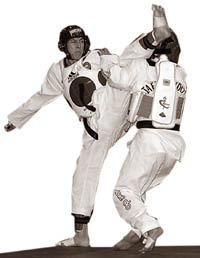
Combat sports
Is it just about aggression?
Welcome back to the tour through the maze of sports! This week, we
are going on a bit of a rough trail. We are going to accompany you into
the combat sports arena and examine the differences between some
commonly known combat sports.
At a glance, there may be a similarity between karate, taekwondo,
kung-fu, and judo, but, in reality, they are entirely different in
technique and origin, and may even mean something new. Let's find out.
****
Taekwondo

This originated in Korea as a mix of Chinese, Japanese and
traditional Korean fighting styles. 'Tae' means to strike with the foot
and 'kwon' means to strike with the hand and 'do' means the way to do in
Korean. Therefore, Taekwondo is a martial art which involves striking
with the hand and the foot.
Although it is an art involving the hand and foot, it gives more
weight to kicks since the leg is the longest limb of the body and it can
generate a lot of power when compared with the hands. It enables you to
keep more distance from the opponent as well.
This is one area where Taekwondo differs from Karate and Chinese
martial arts significantly. This sport has turned out to be the most
popular martial art in the world and it is also the national sport of
Korea.
****
Kung-Fu

Kung-Fu is the word used to imply the traditional Chinese martial
arts. The origin of this combat sport can be tracked down to the 12th
century BC. As a result, it has influenced certain other types of combat
sports in the region.
The term Kung-Fu is something which became popular in the 20th
century and although it is used synonymously (as another word to
describe) with Chinese martial arts, it is the study in just Chinese
martial arts. Therefore, it is in fact a misconception (wrong belief)
that there is a combat style called Kung-Fu. It rather means 'achieving
success through making some effort'.
As a result, you can even say that a person's kung-fu in swimming is
great, which means that the person has excelled in swimming through
practice. Now, did all of this confuse you? If so, the idea here is that
there is a wide variety of Chinese martial arts and Kung-Fu is a term
which is used as a practice nowadays for convenience to imply them.
****
Judo

Judo is purely a sport of Japanese origin and was founded by Dr.
Jigoro Kano in 1882. Judo means 'the gentle way' in Japanese. Now, that
is quite a weird name for a combat sport, isn't it? However, judo is one
of the main types of wrestling at competitive level. The strategy in
this type is using the opponent's energy against himself/ herself as
done in karate.
There are two phases in a judo combat, namely the standing phase and
the ground phase. In the standing phase, the opponents try to throw each
other to the ground and in the ground phase, one tries to grab the
opponent and lock him or her which would then defeat the player who is
grabbed.
This situation is called the 'submission' and in judo, armlocks,
chokes and strangling is used to get the opponent to submit.
****
Karate
 The name is sure to be very familiar to you. Although it is generally
accepted that karate originated in Japan, the actual story is a bit more
complicated. Karate originated in Okinawa in the Ryukyu island group.
But, this became part of Japan only in 1894 and the sport was already
sort of ready-made when Japan took over. Therefore, the truth is that
karate has a Ryukyuan origin, rather than purely Japanese. The name is sure to be very familiar to you. Although it is generally
accepted that karate originated in Japan, the actual story is a bit more
complicated. Karate originated in Okinawa in the Ryukyu island group.
But, this became part of Japan only in 1894 and the sport was already
sort of ready-made when Japan took over. Therefore, the truth is that
karate has a Ryukyuan origin, rather than purely Japanese.
The meaning of the word 'karate' is derived by breaking it up into
two parts. 'kara' means empty, and 'te' means hand, so that when
combined it becomes 'empty hand'. This implies that karate originated as
a sport where physical contact was not encouraged, and the opponent was
weakened by manipulating his own responses. But, it has evolved into a
game where a lot of punching and kicking is involved.
Karate can be divided into three components (basics) such as 'kihon',
'kata' and 'kumite'. 'Kihon' focuses on the fundamentals of karate which
are speed, balance, timing, and concentration and not just the kicks and
punches.
'Kata' is the fraction (part) which define the pattern of actions,
which means that the shots are not just movements, but a proper sequence
(arrangement of things in successive order) of actions. 'Kumite' implies
(indicates) the way that contact is made with the opponent.
Aravinda Dassanayake
[email protected] |


